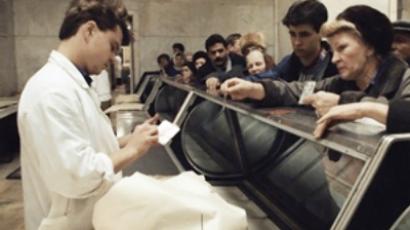Russo-American WWII hero celebrated
The extraordinary life story of “Jumpin’ Joe” Beyrle, a G.I. who managed to fight the Nazis in both the Soviet and US armies, is being celebrated in an exhibition in St. Petersburg.
His son John – the current US ambassador to Russia – says the story is a memorable example of the wartime alliance between the two nations.
In 1944, 20-year-old paratrooper Joseph Beyrle was dropped over Northern France as the allies opened the second front. Just three days later, however, he was captured by the Germans and spent the next 10 months being moved between at least seven concentration camps.
“You have never lived until you have been interrogated by the Gestapo,” Jumpin’ Joe later said in an interview.
When US troops found Joseph's dog tag on a body, his family back home in Michigan received the news they had always feared: their son had been killed in action. Little did they know it had actually been found on the remains of a Nazi soldier who had stolen Joseph’s dog tag.
“There was somebody up there looking after me… that wasn’t my time to go,” Beyrle said.
It certainly wasn’t, because despite having been tortured and starved, in January 1945 he managed to escape from his last camp. He ran for an entire day, hoping to be reunited with the US army, but instead he came across a Soviet tank brigade.
“I knew two Russian words at that time, ‘Americansky tovarishch!’ I said I wanna go with you to Berlin and defeat Hitler,” Beyrle recalled.
And so he found himself heading to do exactly that. Standing side by side with Soviet soldiers, Joseph Beyrle liberated the very camp he'd escaped from just weeks ago. Berlin wasn’t much further, but for Joseph it wasn’t to be.
A series of injuries meant he wound up in a Soviet hospital but, as fate had it, it led to a chance encounter with the Marshal of the Soviet army, and his chance to go home.
“About his meeting with Marshal Zhukov – with no papers, no proof, no dog tag – he understood that man was his home ticket home. He described how Zhukov turned over his shoulder and said something to his aides – the way generals do, he said. They made a decision, but he didn’t know what that decision was until the next day, when he got a letter from Zhukov which gave him the chance to go home,” John Beyrle says.
Beyrle Jr. adds that his father’s story, from an early age, cultivated deep respect and admiration within him towards Russia.
And while Joseph Beyrle always said heroes are only those who never return, he was proclaimed a hero of two nations.
The story of Joseph Beyrle has always been too big to stay at home. With the exhibition opening in Russia, it is a chance for new generations to learn about one man's army experience of being both in the US and in the USSR.
Joseph Beyrle died in 2004, but his story will continue to fascinate people all over the world for many years to come, being not only a symbol of people’s heroism, but also a vivid reminder of a true and unshakable friendship between Russia and the US.













